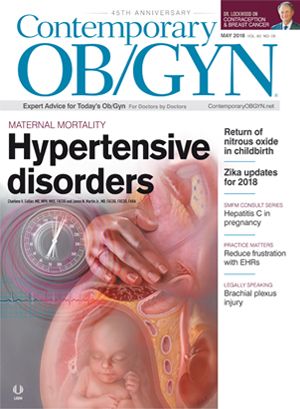Risks and benefits of hormonal contraception
Since hormonal contraception was introduced in the 1960s, the risks and benefits of the drugs have been the subject of considerable, and at times acrimonious, debate.
Charles J Lockwood, MD, MHCM

Since hormonal contraception was introduced in the 1960s, the risks and benefits of the drugs have been the subject of considerable, and at times acrimonious, debate. Some risks have been well-established. For example, risk of thromboembolism is increased in users of combined oral contraceptives (OCPs) compared to non-users (relative risk [RR] of 3.5; 95%CI: 2.9-4.3) with estrogen exerting the major influence, though third-generation progestins also exert modest provocative effects.1 Far more controversial has been the putative link between hormonal contraception and breast cancer. A number of recent publications drawn from a large Danish national database add clarity to this debate and indicate that while on balance hormonal contraception confers net health benefits beyond its outstanding contraceptive efficacy, the progestin component of such therapy is associated with a modest increased relative risk of breast cancer.
Breast cancer risks
In 1996 the Collaborative Group on Hormonal Factors and Breast Cancer analyzed 54 studies and reported that
hormonal contraceptives used in the 1980s were linked to a modest increased risk of breast cancer diagnoses among current OCP users (RR 1.24; 95%CI: 1.15-1.33) and among users within the past 10 years but that this risk dissipated 10 years after use. Of note, cancers diagnosed among OCP users tended to be early-stage, lower-risk lesions.2 The authors did note that women who began OCPs prior to age 20 years had higher relative risks but that the absolute risk of such cancers was low.
Similar findings were noted in the Nurses’ Health Study where current OCP use was associated with a higher risk of breast cancer (RR 1.33; 95%CI: 1.03-1.73) though the association with past use did not reach statistical significance (RR 1.12; 95% CI: 0.95-1.33).3 This study also reported that current use of triphasic levonorgestrel formulations was associated with a particularly elevated risk (RR 3.05; 95% CI: 2.00-4.66). In contrast, other large observational and case-control studies have shown no association between current and past use of OCPs and breast cancer.4,5 These older studies have been criticized for including patients who used higher-dose formulations. Complicating matters further, data from the Women’s Health Initiative (WHI), albeit in an older population, have implicated the progestin component of postmenopausal hormone therapy as the primary culprit in the higher rates of breast cancer seen in this population, with estradiol therapy alone being protective.6 Thus, there are at least theoretical reasons why OCPs and progestin-only forms of contraception may be linked to breast cancer.
Contemporary data
For all these reasons, results of the recent large prospective study by Mørch and colleagues are an important advance in our understanding the relative and absolute risks of breast cancer conferred by hormonal contraception.7 In Denmark, nearly 40% of women between ages 15 and 49 use hormonal contraception. Moreover, a fortuitous alignment and integration of national health-related registries and databases afforded the investigators the opportunity to examine the association between specific hormonal contraceptives, their precise duration of use and interval from discontinuation with the subsequent diagnosis of breast cancer. The authors were thus able to study the link between breast cancer and OCPs with low estrogen doses and a wide variety of progestins, as well as with progestin-only formulations. The ascertainment of women’s contraceptive use in the population and the accuracy of cancer diagnoses were very high and investigators were even able to adjust for a number of cofounders.
Mørch et al. were able to follow 1.8 million women between ages 15 and 49 from 1995 through 2012 for an average of 11 years of follow-up. Of these individuals, 11,517 ultimately received breast cancer diagnoses. Compared with “never users,” women receiving “any” hormonal contraceptive had an adjusted (adj) RR of breast cancer of 1.2 (95%CI: 1.14-1.26). Adding biological plausibility to this finding, the investigators noted that risk of breast cancer increased with duration of exposure from an adjRR of 1.18 (95%CI: 1.10-1.25) among women with 1 to 5 years of use, to 1.38 (95%CI: 1.26-1.51) for those with more than 10 years of use. Among women using OCPs as their form of hormonal contraception for more than 10 years, the risk was 1.46 (95%CI: 1.32-1.61) – a nearly 50% increase. Fortunately, the risk decreased after cessation of therapy, though it did not disappear entirely. For example, 10 years after stopping any hormonal contraceptive, the risk was 1.08 (95%CI: 0.97-1.20) versus 1.05 (95%CI: 0.96-1.16) 10 years after stopping OCPs. For women using hormonal contraceptives 5 to 10 years, the residual risk declined minimally from 1.33 (95%CI: 1.11-1.59) to 1.30 (95%CI: 1.06-1.58). Interestingly there was little difference among various OCP formulations and risk with levonorgestrel-releasing intrauterine devices (IUDs) was essentially the same as for oral agents (1.21; 95%CI: 1.11-1.33).
As in the Collaborative Group study, there was a suggestion that women who initiated hormonal contraception before age 20, and continued for prolonged durations, had enhanced risks. But only 2 additional breast cancers per 100,000 women under 35 could be ascribed to hormonal contraception. Adjusting risks for body mass index, smoking and age at first birth did not materially change the results. However, the authors could not adjust for other breast cancer risk-modifying factors including age at menarche, breastfeeding, alcohol use, and exercise. Finally, while RRs were increased across the entire population, absolute risks remained low – there was 1 additional breast cancer diagnosis per every 7690 women using hormonal contraception for a year!
Benefits of hormonal contraception
Counter-balancing the low absolute risk of breast cancer attendant hormonal contraception are a host of health benefits, first among them lower overall rates of cancer! Hannaford and associates interrogated a UK data base containing 339,000 woman-years for never users of OCPs compared with 744,000 woman-years for ever users of OCPs.8 Compared with never users, OCP ever users had statistically significant lower rates of colon, endometrial and ovarian cancers as well as lower overall rates of malignancies. In contrast, there was a modest increase in cervical cancer rates that likely reflected reduced condom use. The reduction in serous epithelial ovarian cancer risk associated with OCP use is particularly striking. One systematic review of 45 epidemiological studies found that 10 years of OCP use reduced ovarian cancer rates prior to age 75 from 1.2 to 0.8 per 100 users.9 Additional benefits of OCPs include treatment of dysmenorrhea, and polycystic ovarian disease-associated hirsutism, acne and anovulatory bleeding. Progestin-containing IUDs are particularly effective at reducing menorrhagia.
Take-home message
Use of progestin-containing contraceptives appears to be modestly linked to an increased incidence of breast cancers among current and past users. This risk increases with duration of use, but also attenuates > 5 to 10 years off treatment. Since most breast cancers occur in women after 40, it seems prudent to switch from hormonal contraceptives to non-hormonal methods such as copper IUDs, tubal ligations, vasectomy and barrier methods after age 35. This will also help mitigate risks of venous thromboembolism, stroke and myocardial infarction in this older age group. Women with a strong family history of breast cancer might consider such non-hormonal approaches even earlier. As in so many clinical settings, accurate, concise and clear counseling of patients about the risks, and many benefits, of hormonal contraception is the cornerstone of good practice.
References:
- de Bastos M, Stegeman BH, Rosendaal FR, et al. Combined oral contraceptives: venous thrombosis. Cochrane Database Syst Rev. 2014 Mar 3;(3):CD010813.
- Collaborative Group on Hormonal Factors in Breast Cancer. Breast cancer and hormonal contraceptives: collaborative reanalysis of individual data on 53 297 women with breast cancer and 100 239 women without breast cancer from 54 epidemiological studies. Lancet. 1996 Jun 22;347(9017):1713-27.
- Hunter DJ, Colditz GA, Hankinson SE, et al. Oral contraceptive use and breast cancer: a prospective study of young women. Cancer Epidemiol Biomarkers Prev. 2010 Oct;19(10):2496-502. doi: 10.1158/1055-9965.EPI-10-0747. Epub 2010 Aug 27.
- Vessey M, Yeates D. Oral contraceptive use and cancer: final report from the Oxford-Family Planning Association contraceptive study. Contraception. 2013 Dec;88(6):678-83.
- Marchbanks PA, McDonald JA, Wilson HG, et al. Oral contraceptives and the risk of breast cancer. N Engl J Med. 2002 Jun 27;346(26):2025-32.
- Chlebowski RT, Anderson GL, Aragaki AK, Prentice R. Breast cancer and menopausal hormone therapy by race/ethnicity and body mass index. J Natl Cancer Inst. 2015 Nov 5;108(2).
- Mørch LS, Skovlund CW, Hannaford PC, Iversen L, Fielding S, Lidegaard Ã. Contemporary hormonal contraception and the risk of breast cancer. N Engl J Med. 2017 Dec 7;377(23):2228-2239.
- Hannaford PC, Selvaraj S, Elliott AM, Angus V, Iversen L, Lee AJ. Cancer risk among users of oral contraceptives: cohort data from the Royal College of General Practitioner’s oral contraception study. BMJ. 2007 Sep 29;335(7621):651.
Recap on reproductive rights with David Hackney, MD, MS
December 20th 2022In this episode of Pap Talk, we spoke with David Hackney, MD, MS, maternal-fetal medicine physician at Case Western Reserve University and chair of ACOG's Ohio chapter for a full recap of where restrictions on reproductive rights have been and where they're going.
Listen
In this episode of Pap Talk, Gloria Bachmann, MD, MSc, breaks down what it means to be a health care provider for incarcerated individuals, and explores the specific challenges women and their providers face during and after incarceration. Joined by sexual health expert Michael Krychman, MD, Bachmann also discusses trauma-informed care and how providers can get informed.
Listen
No link found between hormonal contraception and clitoral adhesion severity
February 28th 2025A recent study presented at the ISSWSH 2025 Annual Meeting found no significant association between hormonal contraceptive use and the severity of clitoral adhesions, though researchers emphasize the need for further investigation.
Read More

